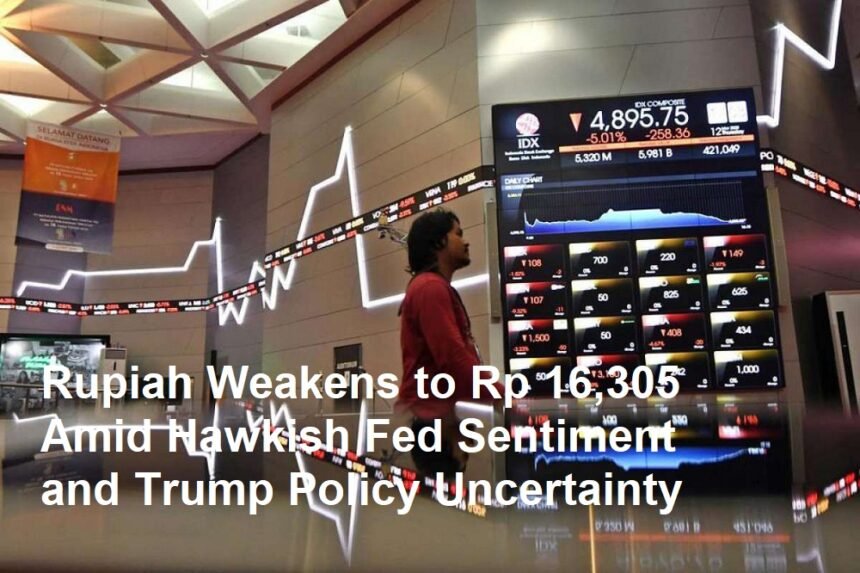JAKARTA, Indonesia — The Indonesian Rupiah plunged to a four-month low of Rp 16,305 per US dollar on Thursday, driven by a strengthening greenback following hawkish signals from the Federal Reserve and mounting uncertainty over former U.S. President Donald Trump’s potential policy shifts. The currency’s depreciation underscores the vulnerability of emerging markets to global macroeconomic volatility and geopolitical risks.
Hawkish Fed Fuels Dollar Strength
The Federal Reserve’s latest meeting minutes, released Wednesday, reinforced expectations of prolonged high interest rates as policymakers emphasized the need to combat stubborn inflation. With U.S. core inflation hovering at 3.4% year-on-year, Fed officials signaled reluctance to cut rates before late 2024, a stance that has bolstered the U.S. dollar.
- Dollar Index Surge: The U.S. Dollar Index (DXY), which measures the dollar against a basket of major currencies, climbed to 105.5, its highest level since April.
- Capital Outflows: Emerging market currencies, including the Rupiah, have faced pressure as investors pivot to higher-yielding U.S. Treasuries. Indonesia’s 10-year government bond yields rose 15 basis points to 6.8%, reflecting reduced demand.
“The Fed’s ‘higher for longer’ narrative is a headwind for Asian currencies,” said Wisnu Wardana, chief economist at Bank Danamon. “Indonesia’s central bank faces a tough balancing act between stabilizing the Rupiah and supporting economic growth.”
Trump Policy Risks Amplify Jitters
Adding to the Rupiah’s woes are growing concerns over potential policy changes under a possible second Trump administration. Analysts warn that Trump’s campaign rhetoric—including threats of 10% tariffs on all imports and a confrontational trade approach toward China—could destabilize global markets.
- Trade War Flashbacks: During Trump’s 2017–2021 term, his trade wars with China and withdrawal from international agreements roiled emerging markets. Indonesia’s exports, particularly coal and palm oil, suffered from reduced Chinese demand.
- Commodity Sector at Risk: A renewed U.S.-China trade clash could dampen commodity prices, a critical revenue source for Indonesia. Coal and palm oil account for 15% of the nation’s export earnings.
“Trump’s protectionist policies would disrupt supply chains and weaken risk appetite for emerging markets,” warned Radhika Rao, senior economist at DBS Bank. “Indonesia’s export-reliant economy is particularly exposed.”
Domestic Implications: Inflation and Central Bank Response
The Rupiah’s slide has raised alarms over imported inflation, as Indonesia relies heavily on foreign goods for fuel, electronics, and raw materials. Consumer prices rose 3.1% year-on-year in June, nearing the upper limit of Bank Indonesia’s (BI) 2.5–4% target range.
- BI’s Tightrope Walk: BI has intervened in forex markets and held its benchmark rate at 6.25% since October 2023. However, further depreciation could force rate hikes, stifling Indonesia’s 5.1% GDP growth.
- Exporters’ Silver Lining: A weaker Rupiah benefits sectors like textiles and tourism. Yet, with 60% of manufacturing inputs imported, broader industrial gains may be limited.
Historical Context and Market Sentiment
The Rupiah has historically been sensitive to Fed policy shifts. During the 2013 “Taper Tantrum,” it plummeted 21% as the Fed scaled back quantitative easing. More recently, Trump’s 2018 tariffs saw the currency weaken to Rp 15,200 per dollar.
Despite current pressures, some analysts remain cautiously optimistic.
- Foreign Reserves Buffer: BI’s $140 billion forex reserves provide ammunition to stabilize the Rupiah.
- Structural Reforms: President Prabowo Subianto’s push for nickel downstreaming and infrastructure investment could attract long-term capital.
Outlook: Turbulence Ahead
With the Fed unlikely to pivot before December and U.S. election uncertainty looming, analysts predict the Rupiah will trade between Rp 16,000–16,500 in the short term. BI Governor Perry Warjiyo has pledged to “use all tools” to maintain stability, but global forces may outweigh local efforts.
Aditya Wardhana, Forex Trader at Monex Investindo:
“Investors are pricing in a ‘risk-off’ scenario. Until the Fed softens or Trump’s policies clarify, the Rupiah will remain under pressure.”
Conclusion
The Rupiah’s slump to Rp 16,305 highlights Indonesia’s exposure to external shocks in an increasingly fragmented global economy. While BI’s interventions and robust reserves offer some defense, the currency’s trajectory hinges on the Fed’s next moves and the U.S. political climate. For now, businesses and policymakers must brace for a prolonged period of volatility.
Key Takeaways:
- Fed rate cut delays and Trump’s trade threats are primary Rupiah drags.
- Imported inflation risks may compel BI to hike rates, slowing economic growth.
- Diversification and structural reforms are critical to long-term resilience.
Investors are advised to monitor the Fed’s July meeting and U.S. election polls for directional cues.













